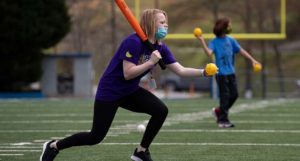Originally published April 19, 2021 by WCU Stories.
By Melanie Threlkeld McConnell
Teaching health and physical education to a group of middle school students during a pandemic via Zoom is not as impossible as it may sound.
A group of Western Carolina University health and physical education majors discovered this past school year when they had to tweak their internships at the Catamount School to comply with COVID-19 restrictions.
Their takeaway after learning to adapt their lesson plans to an online delivery system? Meet the kids where they are, make it fun and hope for the best.

Western Carolina interns learn how students in remote classes do while taking PE over Zoom. (WCU photo)
“Honestly, as we were beginning preparations to teach for our schools we had no idea what to expect. We had plans to adapt our lessons to keep the students engaged and ready to learn, but we expected the participants would not be so eager to be active because they’re confined to their homes,” said Frank Minervini Jr., a senior from Edison, New Jersey. “It has been such a wonderful experience. My students have exceeded my expectations on overall participation and enthusiasm on the virtual aspect of teaching Health and Physical Education.”
Thankfully, the interns had to teach the curriculum to most of the students remotely for only the first three weeks of the spring semester, said Dan Grube, associate professor in the Health and Physical Education program. That’s because the Catamount School is a university entity, which meant when WCU decided to go remote the first three weeks of the semester, the Catamount School followed. And when the university reverted to face-to-face learning, the Catamount School did too, using the alternating group A and group B plans. However, the third group, group C, which had opted out entirely of face-to-face instruction, would continue its remote learning for the rest of the year, Grube said.
Working with eight to 10 students each week – the number fluctuated as families vacillated on whether their kids would be remote-only learners – the interns provided a short demonstration video of a physical activity the kids could do at home with little or no equipment, Grube said.
Then the students were required to complete a worksheet to document their participation in that activity over the course of the week, submitting the report each Wednesday.
For example, one assignment included, among other things, jogging in place, lunges, inch worms plus a push up and a couch stretch at the end, which is exactly what it sounds like. Using a couch or chair to stretch the quads after a workout.
Were the interns ready for online teaching? “We had a collection of faculty in the School of Teaching and Learning who put together a crash course on how to teach online to help interns across all programs prepare,” Grube said. “At some point they were going to have to do that in one way or another. All of the interns were required to engage with those modules as a requirement of their internship. But the faculty decided to focus that professional development on giving the interns some basic skills on how to teach through Zoom.”
For Caleb Henson, a senior from Canton who had recently enlisted in the Army National Guard, entering his internship was a bit of juxtaposition to his personal life. “I had actually just finished 10 weeks of basic training in Fort Benning, Georgia, and didn’t really know what was going on in the schools concerning the pandemic,” he said. “I knew that if the students were going to be virtual, student teaching in physical education would be very difficult due to the students’ participation and attitude toward PE. Getting students excited about exercising and being active is a difficulty we face when students are in class, and I knew teaching online would be a huge challenge trying to get students to be active when all they have to do is turn off their camera when they didn’t want to participate.”
Which did happen, Grube said. “One of the harder things about using Zoom, and I’m aware this is an issue probably nationwide, but certainly in our region, is kids not being able to turn their cameras on and unstable WiFi, or in the case of middle school, some of our kiddos were just embarrassed. They didn’t want to be seen, they didn’t want to be seen doing exercises, they didn’t want people looking in to wherever they might be having to Zoom from.
“We did struggle a little bit with wondering what was going on behind the black screen and the name, but we did our best to try to engage with them and to provide them what we’re required to do by state law.”
One intern, Reanna Lehman, a senior from Sylva, could relate to those students who struggled with online learning. She did, too. “One positive that has come out of this year is learning what type of learner I am,” she said. “I learned through the pandemic that I am a hands-on learner and need to be in person. I do not thrive online because of the structure of it.”
Lehman wasn’t the only one to see silver linings in what initially could have been a dark, gray lingering cloud caused by COVID-19 restrictions.
“I have grown closer with my students no matter that we began virtually,” Minervini said. “Our dynamic has been created, and our bond between teacher and student is going wonderfully. I couldn’t be happier to be a student intern at TCS.”
“I’ve learned how much I enjoy being a teacher and getting to have fun and interact with my students,” Lehman said.
“Although it is harder now, I know this experience will make me a better educator and will teach me lessons I can use my whole career,” Henson said. “I have always thought that challenges allow other things in life to be easier, and I know that will be true coming from this challenge.”
Learn How the IHT Spirit System Encourages Students to Be Active:




